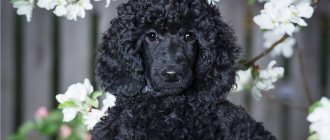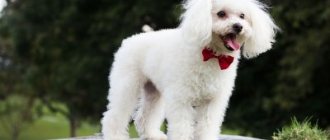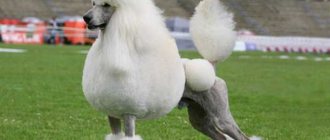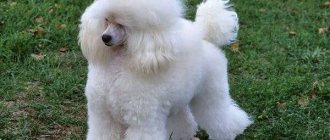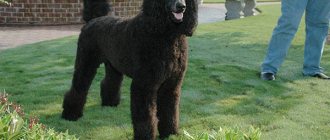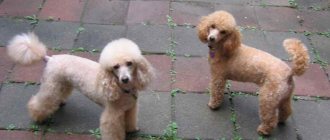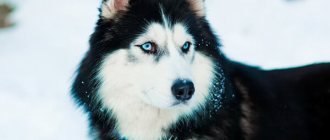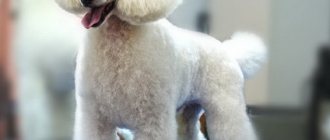Poodle lovers probably know about the variety of colors, but many of them are not recognized by standards, although regardless of coat color, a poodle remains a poodle and its owner’s favorite.
The FCI standard specifies only six colors of poodles, but when dogs with different coat colors are crossed, unusual puppies are born. At the same time, it is very difficult to specifically breed dogs with unusual hair; this phenomenon is often unpredictable, although if you understand the genetics of colors, then sometimes you can achieve the desired result. One of the main requirements is that the wool must be evenly colored.
Breed varieties
There are several types of poodles, differing in appearance. The FCI standard officially recognizes 4 height varieties: large, small, dwarf, toy. The first two are conventionally classified as service and sporting dogs, the second two are classified as decorative dogs. Let's look at each type in detail.
Big
The large (standard, royal) poodle looks presentable and intelligent. These are the largest and tallest dogs of all four varieties. The height of a male dog at the withers reaches 65 centimeters. Bitches are smaller - 58-62 cm.
The character of large poodles is balanced, non-aggressive and intelligent - the pet will not descend to sabotage.
Pets get along well with children and other animals in the house, but due to their natural independence they remain somewhat aloof. Dog handlers note that in case of danger, dogs can show guard qualities. It is better to keep a royal poodle in an apartment, while walks and physical activity are necessary elements of maintenance.
Royal poodles are enviable long-livers. Their life expectancy is at least 15 years. With good care they can live up to 18.
Small
Small poodles are recognized by the Fédération Cynologique Internationale, but many cynologists do not distinguish this variety as a separate one and classify it as royal or dwarf. The height at the withers is 35-46 centimeters, otherwise they do not differ from large ones either in temperament or appearance.
These agile and fast animals also need daily walks and feasible physical activity. Small poodles show good results in agility and flyball competitions. Life expectancy is 12-15 years.
Dwarf
The height of dwarf poodles is a maximum of 35 centimeters. These are tame ladies' dogs that look glamorous and pampered. However, appearances are deceiving; in fact, dogs are hardy, dexterous and brave. They get along well with children, but experienced dog breeders do not recommend leaving miniature dogs alone with children.
Children cannot always calculate their strength and accidentally injure their pet during the game.
Toy poodles are non-aggressive and indifferent to strangers. They constantly demand attention to themselves, become offended and become depressed if they are left alone for a long time. Children live from 14 to 16 years old.
Toy poodle
The Toy is the smallest type of poodle. The height of the animal is only 25 centimeters. The acceptable parameter is 28 cm. Life expectancy is 12-15 years.
Toy dogs look cute and touching, which is why they are very popular. Despite their modest size, these little ones are very brave and willful and can even bite if they don’t like something. At the sight of strangers, they burst into loud, piercing barks and are generally quite noisy and mischievous. They are easy to train and are happy to learn tricks.
Miniature Poodles are ideal for retirees and homebodies. But families with small children are better off not having them. Due to their age, children do not yet know how to calculate strength and can unknowingly cause harm to a toy dog.
Training and education
The dog must know the basic commands. The puppy must already be taught to respond to “Ugh” and “Come.” These commands will prevent your pet from picking up food on the street and will bring the dog back if the leash comes unfastened. When training a poodle, you can’t scold him for not following a command, but you should definitely reward him for doing something correctly with a piece of treat. Lessons are held several times a day, and their duration should not be more than 15 minutes.
When a poodle begins to misbehave, physical punishment is not required. For an animal to understand that it is wrong, a stern tone from a person is enough. The dog quickly learns the boundaries of what is permitted and rarely goes beyond them.
Important! The dog that is going to be exhibited must be trained to show its teeth, stand and walk correctly. The animal is prepared from an early age and often with the assistance of a dog handler.
Colors, coat types
In addition to height varieties, poodles differ in coat type. It can be curly or corded. The most common are dogs with curly hair, consisting of neat curls of different sizes that spring back when pressed with your hand.
As for color, according to the breed standard there are six of them:
- white;
- black;
- red (recognized only in 2007);
- brown (chocolate);
- apricot (peach);
- silver (gray).
Among non-standard combinations, black and tan, sable, and harlequin are allowed. The brindle color is considered unrecognized. Merle (marble) coat color is absent in the genotype of poodles.
Genetics of poodle colors
The most notable feature of the Poodle dog breed is their unique curly coat. The owners of these pets go to any lengths to make them even more beautiful - they do all sorts of haircuts and styling, braids and ponytails, and come up with a variety of hairstyles. But in addition to the texture of the coat, its color is also important; the type of coat and even the temperament of the dog depends on it. The color of the coat will depend on the color pigment, on the factors that distribute it along the length of the hair, influence the color saturation and determine the presence of spots. Pigments have the form of grains of various shapes, due to which light rays are refracted at different angles and human eyes perceive this refraction as different colors. The coloring of dogs is determined by two groups of pigments - eumelanins (black, brown) and pheomelanins (yellow, red).
The breed is rich in a variety of colors
The B gene locus and the F gene locus are responsible for the process of pigment synthesis in the body. The A gene locus and the E gene locus are responsible for the distribution of pigment along the length of the hair and throughout the body.
The saturation of a poodle's color will depend on how evenly the pigment grains are distributed throughout the hair. If they are located evenly and close to each other, then the color is bright and uniform. The intensity of pigmentation is determined by the D gene locus and the G gene locus. But spotted coat color occurs in poodles with the S gene locus.
Content
- The main character traits of a poodle: female or male?
- Poodle character
- Basic commands
- Raising a dog
In this article you will learn what features of character and behavior are inherent in the poodle. After studying this information about the temperament and disposition of a poodle at different ages, you will get an idea about the breed. Find out how the character of a bitch differs from the behavior of a dog. We hope our article will help you figure out which gender of puppy is best for you.
What it looks like in the photo
The poodle is one of the most popular dogs around the world and according to psychology professor Stanley Coren, these animals take 2nd place in the ranking of the smartest dogs.
According to the standard, there are 4 types of these dogs:
- standard (large, royal) – height at the withers ranges from 45 to 60 cm;
- small or medium – grows up to 35-45 cm;
- miniature or dwarf – height at withers from 28 to 35 cm;
- toy poodle – height less than 28 cm.
The Poodle has a proportional body and is one of the typical mesomorphs who look quite elegant and harmonious . The back is short but flexible, the chest is deep, and they have a strong loin.
The neck is quite strong and has a beautiful curve. The head is elongated, the skull is convex in shape with a clearly defined bump on the back of the head, there is a smooth transition from the forehead to the muzzle.
The eyes are almond-shaped, slightly slanted . Their color varies from almost black, deep brown to amber.
The wool can be corded or curly. Corded wool looks like a fleece, thick, long, the length of each cord is about 20 cm. Curly wool is thin and soft, quite thick, and forms beautiful curls throughout the body.
The ears are hanging type, rather long, set low.
If there is curly hair, the animal's tail is docked by ½ or 1/3. With a corded coat, the tail is left unchanged .
During the active state it is placed above the top level.
Standard colors:
- white;
- black;
- apricot;
- brown;
- grey.
Characteristics
Country of origin
France
Size
average
Height
Standard: 37–39 cm Miniature: 28–30 cm Toy: 25–28 cm
Weight
Standard: 20.5–30 kg Miniature: 12–14 kg Toy: 6.5–7.5 kg.
Age
12–18 years old
IFF breed group
companion dogs
Brief information
- an energetic, brave and very friendly dog that even a child can train;
- very active, need long walks;
- require special attention in grooming.
Non-standard options
Colors that are not included in the appearance standard and are considered defective include:
- brindle;
- sable;
- silver beige;
- coffee;
- blue;
- marble.
A poodle, no matter what coat color it has, always looks impressive and unusual. For a person who has not previously had experience communicating with representatives of this breed, it is important to remember that the intensity of the shade of his pet can be affected by many factors, including nutrition, molting, and hormonal changes.
Similar articles
Interesting Facts
It is not for nothing that representatives of the breed are considered one of the most artistic and funny dogs. A dog named Alfie won the "smiliest dog" award. The nomination was awarded to the animal by the British organization Penguin Books. The jury undoubtedly awarded the award to the cute cockapoo, because he really stood out among the other contestants for his love of life.
The owner of the pet is 30-year-old Dan Salt, who sees this smile every day for a year from the moment he got the dog. Dan assures that positive emotions are always displayed “on the face” of the dog. And it doesn’t matter what he’s doing: lying on the couch or walking down the street.
Salt also assures that not all representatives of the breed are prone to loud barking. His ward Alfie rarely “shows his voice.” The winner of the British competition is also distinguished by good health. Dan has never taken his dog to the vet and hopes that this trend will continue in the future.
Is it possible to influence and correct the character of the poodle?
Raising and training a poodle is of great importance, as soon as you bring him into your home. Do not allow people to chew things, stop attempts to pester strangers while walking, do not allow them to eat from someone else’s hands, pick up food from the floor, or beg for food from you while eating. It is forbidden to jump on and bite people, even to show your love. Only training and proper upbringing will change a dog’s character for the better. The puppy training process is based on the method of motivation, encouragement and praise. It is prohibited and unacceptable to treat the dog harshly during training.
Bitch: character
There is an opinion that poodle females have a more submissive and gentle character. But experts believe that character largely depends on heredity and individual characteristics. There are always exceptions, bitches with a very difficult character, and there are males with an easy-going and submissive character. But still, there is a difference in the behavior of the sexes. There are advantages and disadvantages for female and male genders.
Advantages:
- Strong relationship with owner and home
- Emotionally sensitive perception
- Girls are smarter and smarter than boys
- Accepts training tasks well
- During walks, he runs less in the bushes
- Doesn't rush at strangers
- The breed is ideal for breeding, just one assessment from the exhibition is enough
Flaws:
- Sly
- Periodic menstruation
Basic commands
You will use some commands more often, others less often. But they will still come in handy to easily interact with your poodle and even keep him safe in various situations.
- Aport. One of the most difficult teams. Many people perceive it as very easy and simple, but with many dogs you will have to work hard. This skill is used for other exercises: searching, searching, selecting an item and many others. Usually they are all used in service. When working out a command, “Aport” and “Give” are used, and a gesture is also used.
- Give. On the command “Give” the dog must give up the object.
- Lie. A connecting command that needs to be learned for other commands. In addition, it will not interfere at home or on the street.
- To me. You will need to use this command quite often. So start with this as soon as your poodle puppy learns his name. Never call the dog to punish, and do not scold if it comes on its own, even after mischievousness before it. This behavior on your part may alienate the animal.
- Place. A puppy or an adult dog must clearly know where his place is located. He can sleep anywhere, if you allow it, of course, but he must know this command. You can use it outside the home, marking the place with a leash or your favorite toy.
- Near. It is possible to teach your pet the “Near” command at any age, be it an adult dog or a small puppy. When you move to a new home, you should immediately think about training your puppy.
- Sit. One of the very first commands that a poodle puppy should learn.
- Stand. The command is useful in everyday life, for example, for combing a dog.
- . The prohibiting command is one of the most mandatory and taming it begins from the first day the puppy appears in the house. Requiring the command “Fu!”, “No!”, “No!” - immediately stop the unwanted action.
Health
The cockapoo is a very young breed. Although crossbreeding between the two types of dogs should improve the health of the puppies and make their immune systems stronger, the pets are still not free from diseases typical of poodles and spaniels. The following diseases may pose a threat:
- joint dysplasia;
- retinal atrophy;
- allergy;
- epilepsy;
- kneecap dislocations;
- skin ailments;
- ear diseases;
- stomach torsions, intestinal disorders;
- hypothyroidism.
Features of care
The poodle's coat requires the most careful care..
It needs to be cut every two months; it would be better if a groomer does this. You need to bathe your dog with shampoo quite rarely - no more than 4 times a year, but washing it in clean water can be done weekly.
Twice a month, do not forget to clean the poodle’s ears, sharpen the claws as they grow, and wipe the eyes every day with boiled water . A poodle needs to be brushed three times a week.
A poodle sheds only once, when it changes its puppy hair. During this period, the dog needs to be brushed every day.
Nutritional Features
A poodle can be fed with both natural products and industrial food. It is better to choose one that is saturated with vitamins and minerals to the maximum - this is premium and super premium food.
If you choose natural food, then your diet should include::
- Meat – 70% of the diet (beef, lamb);
- Sea fish once a week;
- Dairy products – kefir, cottage cheese, cheese;
- Vegetables – tomatoes, spinach, carrots, celery, beets, cabbage;
- Porridge – buckwheat, millet, rice.
Origin story
Images of dogs with an elongated muzzle and curly hair date back to antiquity. Archaeologists have found them on Roman and Greek coins and cathedral walls. But France became the birthplace of the breed. This country calls her a national treasure. Although the Germans claim that the breed originates from Germany.
Researchers have not reached a consensus on which breeds poodles originated from. At first they were used for hunting ducks; this dog swims well. But they could do different jobs: protect, herd sheep. A common version is that the breed was created by crossing German sheep poodles and Spanish water dogs. The name suggests this: pudel is a German word that translates as “splash in water.” Many researchers note the kinship of representatives of the breed with pointers, commanders, spaniels, and barbets.
Gradually, poodles became popular among the nobility; only members of royal families were allowed to own these dogs, hence the name of the breed. But there is a version that they were named royal by King Charles, who was saved by such a dog during the English Revolution. And some believe that they call poodles royal because of their aristocratic, proud posture and luxurious coat.
These dogs were often used in traveling circuses, they served as guide dogs and helped hunters. Thanks to their high stature, they could be good defenders and rescuers.
The first description of such dogs appeared back in 1555. Already at that time, three varieties were identified: large, small and dwarf. But the first standard was developed in the 30s of the 20th century. The Great Royal Poodle received official recognition from the International Film Festival only in 1984. This variety has been identified as a separate breed. Sometimes such a poodle is also called standard, in contrast to small and dwarf.
Types of haircuts
There are the following ways to trim a poodle :
- "Lion" or "Continental";
- "Modern";
- "Bikini";
- Puppy;
- “English saddle;
- "Kennel";
- Dutch haircut;
- "Bichon".
Types of crossbreeds (mestizos)
There are the following types of poodle mixes:
- With St. Bernard;
- With Labrador;
- With Yorkshire Terrier;
- With a golden retriever;
- With a Maltese dog;
- With a cocker spaniel;
- With Shih Tzu;
- With collie.

